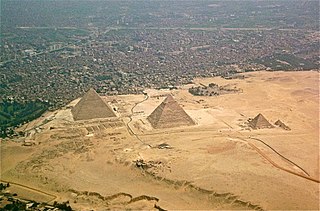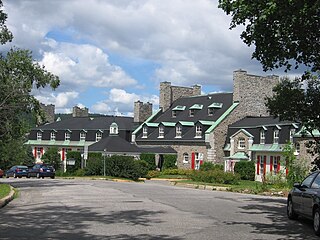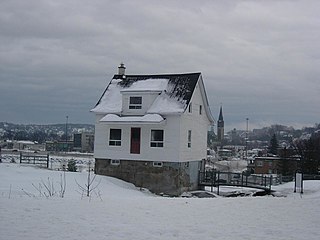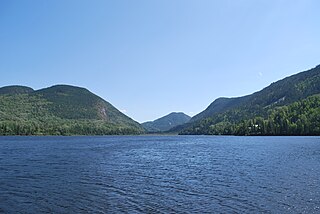
A pyramid is a structure whose outer surfaces are triangular and converge to a single step at the top, making the shape roughly a pyramid in the geometric sense. The base of a pyramid can be trilateral, quadrilateral, or of any polygon shape. As such, a pyramid has at least three outer triangular surfaces. The square pyramid, with a square base and four triangular outer surfaces, is a common version.

Chicoutimi is the most populous borough (arrondissement) of the city of Saguenay in Quebec, Canada.

The Saguenay River is a major river of Quebec, Canada. It drains Lac Saint-Jean in the Laurentian Highlands, leaving at Alma and running east; the city of Saguenay is located on the river. It drains into the Saint Lawrence River. Tadoussac, founded as a French colonial trading post in 1600, is located on the northeast bank at this site.

Saguenay is a city in the Saguenay–Lac-Saint-Jean region of Quebec, Canada, on the Saguenay River, about 200 kilometres (120 mi) north of Quebec City by overland route. It is about 126 kilometres (78 mi) upriver and northwest of Tadoussac, located at the confluence with the St. Lawrence River. It was formed in 2002 by merging the cities of Chicoutimi and Jonquière and the town of La Baie. Chicoutimi was founded by French colonists in 1676.

Saint-Louis-du-Ha! Ha! is a parish municipality in the Témiscouata Regional County Municipality of the Bas-Saint-Laurent region of Quebec. The population is 1,311. Its economy is mainly agricultural. It is located southeast of Rivière-du-Loup and west of Cabano along the Trans-Canada Highway, about halfway to Edmundston in New Brunswick.

Baie-Comeau is a city located approximately 420 km (260 mi) north-east of Quebec City in the Côte-Nord region of the province of Quebec, Canada. It is located on the shores of the Saint Lawrence River near the mouth of the Manicouagan River, and is the seat of Manicouagan Regional County Municipality.

Le Fjord-du-Saguenay is a regional county municipality in the Saguenay-Lac-Saint-Jean region of Quebec, Canada. Its seat is Saint-Honoré, which is also its most populous municipality.

La Baie is one of three boroughs in the city of Saguenay, Quebec, Canada. It was created during Quebec's municipal reorganization in 2002. From 1976 to 2001, it was known as the Town of La Baie, a municipality composed of the Grande-Baie, Bagotville and Port-Alfred sectors.

The Saguenay flood was a series of flash floods on July 19 and 20, 1996 that hit the Saguenay–Lac-Saint-Jean region of Quebec, Canada. It was the biggest overland flood in 20th-century Canadian history.

Jean Tremblay is a Canadian businessman and politician who was mayor of Saguenay, Quebec, Canada from 2002 to 2017. Before that he was mayor of Chicoutimi since 1996.

Saguenay Fjord National Park is a provincial park located in Quebec, Canada. In the regions of Saguenay–Lac-Saint-Jean, Charlevoix, Côte-Nord, and Bas-Saint-Laurent, the park is situated along the eastern end of the Saguenay River and adjoins the Saguenay–St. Lawrence Marine Park for over 100 km (60 mi.).
This is a list of elections in Canada in 2016. Included are provincial, municipal and federal elections, by-elections on any level, referendums and party leadership races at any level.
The Zec River to Mars is a "zone d'exploitation contrôlée" (ZEC) in the unorganized territory of Lac-Ministuk, in the Le Fjord-du-Saguenay Regional County Municipality, in the administrative region of Saguenay-Lac-Saint-Jean, in Quebec, in Canada.

The Ha! Ha! River is a watercourse in Saguenay–Lac-Saint-Jean, Quebec, Canada.

Lake Ha! Ha! is a waterbody tributary of the Ha! Ha! River. It is located in the municipality of Ferland-et-Boilleau, Quebec, in the Le Fjord-du-Saguenay Regional County Municipality (MRC), in administrative region of Saguenay-Lac-Saint-Jean, in Quebec, located in the Saguenay River valley, in Canada.

The Baie des Ha! Ha! is a particularly developed cove over a length of eleven kilometres on the Saguenay River in the region of Saguenay–Lac-Saint-Jean in Quebec, Canada. At the end of this natural corridor, which was originally called in French the "Grande Anse", then the "Grande Baie", there are the Ha! Ha! River and Rivière à Mars. According to the Second Saguenay theory, this vast depression is the extension of the fault and collapse ditch of the Kenogami Lake which is located upstream less than twenty kilometers.
The "Lac des Cèdres" is the head of the Rivière des Cèdres, in the watershed of Ha! Ha! River And Saguenay River. This body of water straddles the municipality of Ferland-et-Boilleau and Saint-Félix-d'Otis, in the Fjord-du-Saguenay, in the administrative region of Saguenay–Lac-Saint-Jean, in province of Quebec, in Canada.
The Baie des Ha! Ha! is located in the municipality of Gros-Mécatina, in the Le Golfe-du-Saint-Laurent Regional County Municipality, on the north shore of Gulf of Saint Lawrence, in the administrative region of Côte-Nord in eastern Quebec, Canada.

The Rivière à Mars is a tributary of the Baie des Ha! Ha! Crossing the borough La Baie, in Saguenay (city), in the administrative region of Saguenay–Lac-Saint-Jean, in Quebec, in Canada. The "rivière à Mars" is a tributary of the Saguenay River and has its source in the Laurentides Wildlife Reserve. This river to salmons was badly affected by the Saguenay Flood which occurred from July 19 to 21, 1996.
La Petite Décharge is a tributary of La Grosse Décharge, flowing in the unorganized territory of Lac-Ministuk, in the Le Fjord-du-Saguenay Regional County Municipality, in the administrative region of Saguenay–Lac-Saint-Jean, in the province of Quebec, in Canada. The course of "La Petite Décharge" crosses the northern part of the zec Mars-Moulin.


















